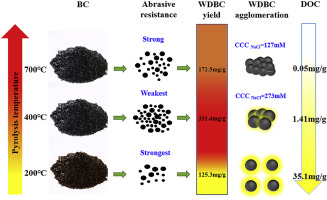Environmental Pollution ( IF 8.9 ) Pub Date : 2020-01-23 , DOI: 10.1016/j.envpol.2020.114037 Jing Fang 1 , Leilei Cheng 2 , Rashida Hameed 3 , Liang Jin 2 , Dengjun Wang 4 , Gary Owens 5 , Daohui Lin 3

|
Pathways for the physical disintegration of biochar (BC) and the release of water dispersible BC colloids (WDBC) have received much attention due to their unique impacts on carbon loss and contaminant. However, the current understanding of the mechanisms involved in WDBC formation and associated influencing factors is rather limited. This study systematically explored the effects of pyrolysis temperature, initial particle size, and solution chemistry on WDBC formation in aqueous solutions and examined the formation and colloidal stability of WDBC in natural solutions. Results showed that pyrolysis temperature determined the abrasion resistance of pyrolyzed BC, and the submicron fragment rate decreased in the order 400 °C (BC400) > 700 °C (BC700) > 200 °C (BC200). The WDBC yield decreased in the order BC400 (77.5–331 mg g−1) > BC700 (33.5–173 mg g−1) > BC200 (16.8–125 mg g−1) depending on BC size at a solution ionic strength (IS) ≤ 1 mM, which was positively correlated with the submicron fragment rate of bulk BC. With the exception of BC200, increasing IS (0.1–20 mM) and decreasing pH (3.0–10.0) significantly inhibited WDBC yield. Release and sedimentation dominated the WDBC formation processes with the former being more susceptible to solution chemistry. Derjaguin-Landau-Verwey-Overbeek interactions properly explained the effect of IS on WDBC from BC400 and BC700, while the steric resistance of abundant dissolved organic carbon on BC200 was mainly responsible for the high formation of WDBC at high IS (20–50 mM). WDBC had high colloidal stability and could form and stabilize well in natural surface waters and soil solutions, suggesting the relevant risk of long-distance migration of WDBC in environments. These findings represent new knowledge regarding the physical decomposition and the fate of BC in the environment.
中文翻译:

水分散性生物炭胶体在水生环境中的释放和稳定性:热解温度,粒度和溶液化学性质的影响。
由于其对碳损失和污染物的独特影响,生物炭(BC)物理分解和水分散性BC胶体(WDBC)释放的途径受到了广泛关注。但是,目前对WDBC形成机制及其相关影响因素的了解还很有限。这项研究系统地探讨了热解温度,初始粒径和溶液化学性质对水溶液中WDBC形成的影响,并研究了WDBC在天然溶液中的形成和胶体稳定性。结果表明,热解温度决定了热解BC的耐磨性,亚微米碎片率的降低顺序为400°C(BC400)> 700°C(BC700)> 200°C(BC200)。WDBC产量下降了BC400(77。)> BC700(33.5–173 mg g -1)> BC200(16.8–125 mg g -1)取决于溶液中离子强度(IS)≤1 mM时的BC大小,该强度与散装BC的亚微米碎片率呈正相关。除BC200外,增加IS(0.1–20 mM)和降低pH(3.0–10.0)会显着抑制WDBC产量。释放和沉淀在WDBC的形成过程中占主导地位,前者更易受溶液化学作用的影响。Derjaguin-Landau-Verwey-Overbeek相互作用正确地解释了IS对BC400和BC700的WDBC的影响,而大量溶解的有机碳对BC200的空间抗性主要是在高IS(20–50 mM)下高浓度形成WDBC的原因。 。WDBC具有很高的胶体稳定性,并且可以在天然地表水和土壤溶液中形成并稳定,这表明WDBC在环境中长距离迁移的相关风险。


























 京公网安备 11010802027423号
京公网安备 11010802027423号